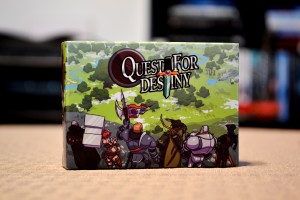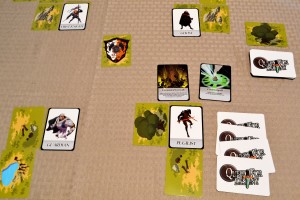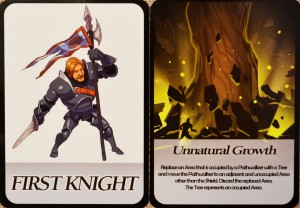No matter how many times I attempt to understand the back story behind “Quest for Destiny”, I come up short and end up reaching for my Tylenol bottle. From what I was able to gather, players will assume the roles of Pathwalkers on a quest to find the Dawn of Zegon. There’s mention of a group called the Scryers who found the special shield within the Great Forest of West Span, which happens to be guarded by one Dragon Lord Kathar. Oh, and mindless thralls. To be fair, there is a “Story Behind the Cards” section at the end of the manual, but my eyes glazed over in the same way as when I attempted to read Tolkien’s “Lord of the Rings”. That begs the question, will the gameplay mechanics be as convoluted as the story? Before we explore that answer, I’d like to thank Desmond Ong from Destiny Makers LLP for reaching out and providing me with a press copy.
Components
Cards – The game comes with a total of sixty-four cards of varying types.
Setup & Gameplay
First, players will need to imagine a 7×7 grid, with the shield card being placed in the middle. Area cards are placed on the starting positions, the latter of which will change depending on how many people are playing the game. The last page of the manual lists a few diagrams to help players out in this regard. Each player then chooses a pathwalker and places it on the starting area closest to them. Tree cards are placed off to the side, with the area and spell cards being shuffled into one draw deck. Each player is dealt a hand of four cards and the youngest player goes first.
This game is broken up into turns, with each player performing a particular step-by-step process on their turn. That process can be summed up as follows:
Step 1 : Either play an area card or a spell card.
Area cards form the path on which players will be traveling. As such, area cards can only be placed adjacent to the current player’s location and they cannot be played on an existing area. Those who cannot or will not play a card must discard and draw a new card.
Step 2: Move your pathwalker to an adjacent, unoccupied area.
Players who played an area card in step one must move their pathwalker onto said area card.
Step 3 : Draw from the card deck to replenish your hand to four cards.
When the deck is depleted, the discard pile is reshuffled and becomes the new deck.
Players will continue taking turns until one player manages to reach the shield in the center of the grid. The person who does so, wins the game.
The above doesn’t cover all of the rules found in the manual, but should give you a general feel of how the gameplay flows. For more information, please follow the links at the end of this article.
The Review
In terms of quality, the cards (I felt) were thick and pretty well made. The art is attractive and the text was fairly easy to read. I’m sorry that the same can’t be said for the box the cards game in. While the art on the box was attractive, it packaged the cards so tightly that I couldn’t remove the cards from the box without ripping it. A slightly larger box would have solved that problem.
Perhaps I was unforgivably harsh on the back story presented in the manual. It’s very possible that some folks enjoy the lore behind a game, it’s just a shame that none of the proper nouns mentioned had any real meaning to me. I would have been much happier had the introduction simply said, “Players will assume the role of pathwalkers, who are attempting to be the first to reach the Dawn of Zegon (a powerful shield resistant to magic) in order to thwart evil Dragon Lord Kathar.” There…nice and simple. I like simple. At any rate, to answer the question posed in the introduction of this article, “no, the gameplay mechanics are not as convoluted than the back story.” The game is actually pretty simple to play, supported by the fact that the manual is only two pages long.
Despite its simplicity, the game still offers players a choice, namely in the form of figuring out which cards you’ll be playing next. There are only five different spell card types, which can be both good or bad depending on how you look at it. On one hand, you won’t have to spend hours looking through mounds of cards trying to become familiar with their respective effects. On the other, having only five spell card types can get repetitive after a while. This really limits the gameplay and what tools players have available to them.
That brings me to the price of the product…oh boy, where to begin? The game can be purchased on the official website below for $23.99 (as of 11/18/13). Twenty-four dollars for a deck of sixty-four cards is a bit steep, in my opinion. To be fair, this price includes the international shipping fee, as the game is only local to Singapore and Kuala Lumpur. Still, I’m not sure how many folks would go for that price when incredibly wonderful games like “Talisman” (which has a similar theme) can be purchased for a little more money. There’s also the fact that you need at least four people to play…the price and game limitations alone are enough to scare off even the most dedicated of fans.
Don’t get me wrong, “Quest for Destiny” isn’t a terrible game. I like the fact that’s easy to pick up and play, not to mention family friendly. I also like how the paths are formed by players, rather than players being set on a predetermined path. Though, with only sixty-four cards in the deck (with almost half being plain area cards), there are bound to be repeat strategies after the first game. In a casual group setting, “Quest for Destiny” works best. I calculated the cheapest international shipping fee (from Singapore to the US) to be about $14.99, making the actual price of the product to be about ten bucks. The high price is understandable, but I find myself hard-pressed to recommend this game to anyone outside of its native city/country. If you have the money to burn however, you’ll find “Quest for Destiny” to be a mediocre experience at best. It can be fun, but didn’t really stand out to our family in any special way.
Final Verdict: 5/10
—



